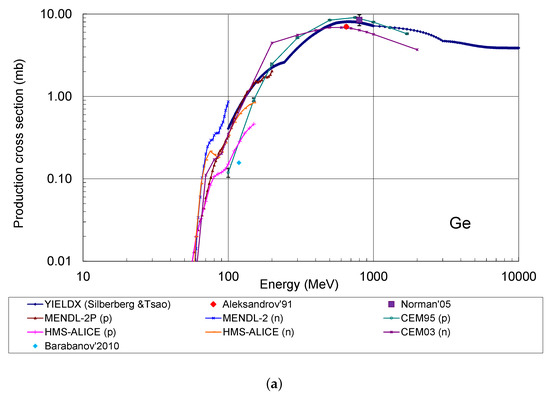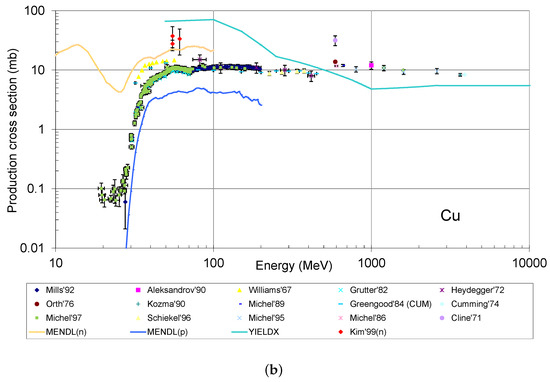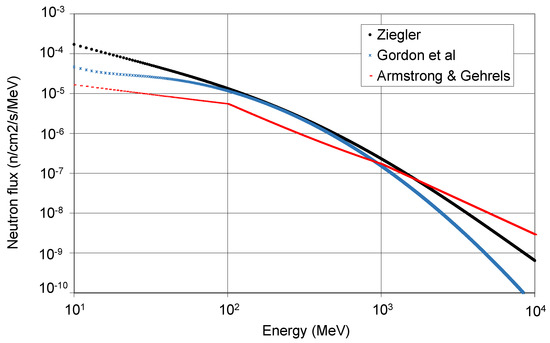
| Version | Summary | Created by | Modification | Content Size | Created at | Operation |
|---|---|---|---|---|---|---|
| 1 | Susana Cebrián Guajardo | + 2000 word(s) | 2000 | 2020-10-10 05:54:28 | | | |
| 2 | Conner Chen | -13 word(s) | 1987 | 2020-10-26 10:15:14 | | |
Video Upload Options
The cosmogenic activation of materials is the production of radioactive isotopes due to the exposure to cosmic rays. On the Earth's surface, spallation induced by cosmic neutrons is responsible of most of the activation, but other reactions and cosmic ray components must be considered too in other conditions, like if materials are flown at high altitudes or stored deep underground.
Cosmogenic activation is relevant in different contexts; for example, together with primordial or anthropogenic radioactivity, it s a background source in experiments devoted to the investigation of rare event phenomena, like the direct detection of dark matter particles or the nuclear double beta decay.
Radioactive impurities in the components used in a low-background experiment induced by the exposure to cosmic rays at the surface (during production, transportation, or storage) may become very problematic, being in some cases even more relevant than the primordial activity. Production of cosmogenic radioactive isotopes is also considered in other fields [1][2] as some products are relevant in different contexts related to Astrophysics, Geophysics, or Archaeology. Here, just the basics of the cosmogenic activation are summarized, describing how it can be evaluated from known production cross sections and considering the cosmic ray spectrum.
Many particular studies have been developed to quantify and reduce the activation yields in detectors and materials used in the set-up of experiments demanding ultra-low background conditions, considering target materials like germanium, silicon, tellurium, xenon, argon or sodium iodide, together with other ones commonly used like copper, lead and stainless steel. Reviews of all these studies can be found in Refs. [3]
1. Cosmogenic Activation
The spallation of nuclei by high energy nucleons is one of the dominant processes for the cosmogenic production of radionuclides, but other reactions like fragmentation, fission, break-up, or capture are important too. Spallation reactions produce the emission of neutrons and charged particles together with the generation of residual nuclei far from the target. They are typically described in two steps: a first one leading to an excited remnant nucleus and a second one, much slower, corresponding to the de-excitation of this nucleus. Isotope production at the Earth’s surface is dominated by neutrons because protons are absorbed by the atmosphere. However, at high altitudes, protons are also relevant for activation and the cosmic flux increases.
Cosmogenic activation of materials underground can be considered in many cases negligible, as the flux of cosmic nucleons is suppressed just for depths of a few tens of meter water equivalent (m.w.e.) and the neutron fluxes in deep underground facilities are orders of magnitude lower than at the surface. Radiogenic neutrons have energies (around a few MeV) too low to produce spallation processes. Therefore, activation underground is mainly due to muons. Negative muon capture is dominant at shallow depths while deep underground fast muon interactions are the most relevant ones: muon spallation (virtual photon nuclear disintegration) and electromagnetic and nuclear reactions from secondary particles. As the muon energy spectra and fluxes depend on depth, underground activation can be very different for different sites. This on-site activation can be problematic for next generation experiments and may set a minimum for the required depths.
The relevant cosmogenic radioisotopes generated depend on the target material, but some spallation products like tritium are commonly induced. Tritium is a pure β− emitter with Q=(18.591±0.001) keV and a half-life of (12.312±0.025) y [4]; therefore, it is very relevant for dark matter searches when produced in the detector medium [5] but has no effect for most of the Double Beta Decay searches. Estimates of tritium yields require the identification of all the final reaction products.
Cosmogenic activation can be minimized by reducing the surface exposure, using shieldings against the cosmic rays, avoiding flights and storing, or even producing, materials underground. Purification techniques can also eliminate many of the induced isotopes. However, these preventive measures make the experiment preparation more complex, for instance for crystal growth or detector mounting. Consequently, it would be advisable to assess the relevance of the material exposure to cosmic rays for the experiments and its effect on the sensitivity. To quantify the induced activity, A, of an isotope with decay constant λ, both the production rate R of the isotope in the considered target as well as the exposure history must be well-known. In particular, A can be computed as:

considering texp the time of exposure to cosmic rays and tcool the cooling time (time spent underground once shielded from cosmic rays).
Some direct measurements of productions rates have been carried out for a few materials from the saturation activity, obtained by sensitive screening of materials exposed in well-controlled conditions. However, in many cases, production rates must be evaluated from the flux (per unit energy) of cosmic rays, ϕ, and the isotope production cross-section, σ, being both ingredients dependent on the particle energy E:

with Nt the number of target nuclei.
2. Production Cross Sections
Excitation functions for the production by nucleons of a particular nuclide in a target over a wide range of energies (from a few MeV up to tens or hundreds of GeV) cannot be obtained just from measurements of production cross-sections with beams. Calculations must be made to have complete information on the excitation functions. The EXFOR database (CSISRS in USA) [6] compiles nuclear reaction data and then cross sections for a particular target, projectile, energy, or reaction can be searched for. Experimental data on production cross sections are scarce but essential to validate calculations.
Different approaches can be considered to compute production cross sections. Semiempirical formulae have been derived for nucleon–nucleus reactions. The Silberberg and Tsao equations presented in Refs. [7][8][9][10][11] can be used for targets with mass number A ≥ 3, for products with A ≥ 6 and for energies >100 MeV. They have been integrated in different codes: COSMO (FORTRAN program) [12], YIELDX (FORTRAN routine, including the latest updates of the equations) [11] and, more recently, ACTIVIA (C++ computer package, using also experimental data when available) [13]. Any of these codes offer very fast calculations, although as the formulae are based only on proton-induced reactions, neutrons, and protons’ cross sections must be implicitly assumed to be equal.
The other approach in production cross sections calculations is the Monte Carlo (MC) simulation of the interaction between nucleons and nuclei. Modeling properly the interactions for isotope production requires the consideration of different reactions: from the formation and decay of compound nuclei to the intranuclear cascade of nucleon interactions followed by de-excitation processes like fission, fragmentation, spallation, or breakup. As described in detail in Ref. [14], many different models and codes have been developed and validated to implement this in different contexts, like, for instance, the production of medical radioisotopes, the transmutation of nuclear waste, the prevention of damage to electronics on spacecraft, the radioprotection of astronauts, or studies of comic rays and astrophysics. Some of these codes have been implemented in general-purpose codes like GEANT4 [15], FLUKA [16], and MCNP [17]. Evaluated libraries of production cross sections have been elaborated, providing different coverage of reactions, projectiles, and energies, like, for example, TENDL (TALYS-based Evaluated Nuclear Data Library) [18] (based on the TALYS code, for protons and neutrons with energies up to 200 MeV) or HEAD-2009 (High Energy Activation Data) [19] (for protons and neutrons with higher energies, from 150 MeV up to 1 GeV).
A more detailed discussion on the different options to undertake the evaluation of cosmogenic production cross sections and yields can be found in [20]. There is no perfect approach, depending the suitability of a model or code to a particular situation on targets, projectiles, and energies. In [20], to analyze a particular product and target, it is proposed to collect and analyze firstly all the information on the excitation functions by neutrons and protons from all the available sources (calculations and experiments); and then, to choose the best description by minimizing deviations. Systematic comparisons between measurements and calculations are usually made based deviation factors, F, defined as:

with n the number of pairs of measured and calculated cross sections σexp,i and σcal,i at a certain energy. As an example, Figure 1 shows a compilation of excitation functions for 60Co, a typical cosmogenic product in different targets, generated in natural germanium and in copper by nucleons taken from different sources, as made in Ref. [43]; the availability of a large amount of experimental data in copper allows a more reliable validation of calculations.


Figure 1. Compilation of excitation functions for the production of 60Co by protons and neutrons in natural germanium (a) and in copper (b). Experimental data obtained from the EXFOR database are shown together with calculations using semiempirical formulae and MC simulations.
3. Cosmic Ray Flux
Together with the production cross sections, the other element to calculate the production rates is the cosmic ray flux and its energy distribution. Nucleons, with energies from MeV to GeV, are responsible for most of the activation produced on the surface. At sea level, the the number of protons and neutrons with energies of a few GeV is roughly the same; but, at lower energies, as charged particles are absorbed in the atmosphere, the proton to neutron ratio is much lower than one, being only 0.03 at 100 MeV [1]. This is the reason why neutrons produced the bulk of the cosmogenic activation at sea level. However, proton activation is not completely negligible; its contribution is quoted in [1] as ∼10%, in agreement with results for proton activation in germanium [21][22]. Activation from other particles like muons can be even smaller [22][23].
Different descriptions of the energy spectrum of neutrons at sea level have been considered for cosmogenic activation studies, like the ones presented in Refs. [24] and [1]. Parameterizations given in [25][26] are used in the ACTIVIA code. In [27], following a revision of all previous available results, a new parameterization valid for energies from 10 MeV to 10 GeV was provided. After a campaign of cosmic neutron measurements in the US, a different analytic function from the fit to data for energies greater than 0.4 MeV was proposed by Gordon et al. [51]. Three different parameterizations (corresponding to the flux at sea level in New York City) are compared in Figure 2; in the range 10 MeV–10 GeV, the integral flux is 5.6 (3.6) ×10−3cm−2s−1 from [27][28]. It is worth noting that, to assess activation at a certain location, the evaluated flux for New York City must be properly scaled using available factors [27] or tools [29].

Figure 2. Differential neutron flux as derived from parameterizations at sea level by Armstrong and Gehrels [25][26], Ziegler [27], and Gordon et al. [28].
For the energy spectrum of surface protons, the CRY (“Cosmic-ray Shower Library”) generator [30] can be used. At sea level, the integral flux in 100 MeV–100 GeV is 1.36 ×10−4cm−2s−1 while the energy spectra for different particles (like nucleons and muons) is obtained from the full MC simulation of primary protons and atmospheric showers. The good agreement with data shows that these calculations give a reliable description of the distributions of cosmic rays at sea level. As discussed in Ref. [31], CRY allows the generation of energies, positions, and directions of different particles, but primary nuclei are not simulated (only protons are considered) and the accuracy of the derived spectra is limited (due to the energy bins defined). The flux of protons and high-energy gamma rays can be also obtained from the EXPACS (“EXcel-based Program for calculating Atmospheric Cosmic-ray Spectrum”) sofware program [32]. It calculates terrestrial fluxes of nucleons, ions with charge below 28, muons, and other particles for different positions and times in the Earth’s atmosphere. Based on these calculated fluxes, EXPACS can also deduce the effective dose, ambient dose equivalent, and absorbed dose in air due to cosmic-ray exposure.
It is also possible to accomplish the full calculation of the production rates with one code. The CONUS (“COsmogenic NUclides Simulations”) toolkit, developed for the analysis of cosmogenic radioisotopes in extra-terrestrial and terrestrial objects [33], can be used to compute production rates in detector materials too. It is based on the MCNPX and MCNP codes combined with LAHET (code for transport of nucleons, pions, muons and light nuclei). An isotropic irradiation with primary galactic cosmic-ray protons is used in calculations. Measurements and TALYS calculations are used for cross sections. Input particles in CONUS are considered with energies from 0.001 eV to 20 GeV.
References
- Lal, D.; Peters, B. Cosmic Ray Produced Radioactivity on the Earth; Springer: Berlin/Heidelberg, Germany, 1967.
- Beer, J.; McCracken, K.; von Steiger, R. CosmogenicRadionuclides. TheoryandApplicationsintheTerrestrialand Space Environments; Springer: Cham, Switzerland, 2012.
- Cebrián, S. Cosmogenic activation of materials. Int. J. Mod. Phys. A 2017, 32, 1743006.
- Decay Data Evaluation Project. Available online: http://www.nucleide.org/DDEP.htm (accessed on 24 September 2020).
- Amaré, J.; Castel, J.; Cebrian, S.; Coarasa, I.; Cuesta, C.; Dafni, T.; Galan, J.; Garcia, E.; Garza, J.G. ; Iguaz, F.J.; et al. Cosmogenic production of tritium in dark matter detectors. Astropart. Phys. 2018, 97, 96.
- ExperimentalNuclearReactionData(EXFOR).Availableonline: http://www-nds.iaea.org/exfor/exfor.htm (accessed on 24 September 2020).
- Silberberg, R.; Tsao, C.H. Partial Cross-Sections in High-Energy Nuclear Reactions, and Astrophysical Applications. I. Targets With z≤28. Astrophys. J. Suppl. Ser. 1973, 25, 315; Partial Cross-Sections in High-Energy Nuclear Reactions, and Astrophysical Applications. II. Targets Heavier than Nickel. ibid.
- Silberberg, R.; Tsao, C.H. Cross sections for (p,xn) reactions, and astrophysical applications. Astrophys. J. Suppl. Ser. 1977, 35, 129.
- Silberberg, R.; Tsao, C.H. Improved cross section calculations for astrophysical applications. Astrophys. J. Suppl. Ser. 1985, 58, 873.
- Silberberg, R.; Tsao, C.H. Spallation processes and nuclear interaction products of cosmic rays. Phys. Rep. 1990, 191, 351.
- Silberberg, R.; Tsao, C.H. Updated Partial Cross Sections of Proton-Nucleus Reactions. Astrophys. J. 1998, 501, 911.
- Martoff, C.J.; Lewin, P.D. COSMO- a program to estimate spallation radioactivity produced in a pure substance by exposure to cosmic-radiation on the Earth. Comput. Phys. Commun. 1992, 72, 96.
- Back, J.J.; Ramachers, Y.A. ACTIVIA: Calculation of isotope production cross-sections and yields. Nucl. Instrum. Meth. A 2008, 586, 286.
- David, J.C. Spallation reactions: A successful interplay between modeling and applications. Eur. Phys. J. A 2015, 51, 68.
- Allison, J.; Amako K.; Apostolakis, J.; Arce, P.; Asai, M.; Aso, T.; Bagli, E.; Bagulya, A.; Banerjee, S.; Barrand, G.; et al. Recent developments in Geant4. Nucl. Instrum. Meth. A 2016, 835, 186.
- Böhlen, T.T.; Cerutti, F.; Chin, M.P.W.; Fassò, A.; Ferrari, A.; Ortega, P.G.; Mairani, A.; Sala, P.R.; Smirnov, G.; Vlachoudis, V. The FLUKA Code: Developments and Challenges for High Energy and Medical Applications. Nuclear Data Sheets 2014, 120, 211.
- Monte Carlo N-Particle Code. Available online: https://mcnp.lanl.gov/ (accessed on 24 September 2020).
- Koning, A.J.; Rochman, D. Modern Nuclear Data Evaluation With The TALYS Code System. Nuclear Data Sheets 2012, 113, 2841.
- Korovin, Yu.A.; Natalenko, A.A.; Stankovskiy, A.Yu.; Mashnik, S.G.; Konobeyev, A.Yu. High Energy Activation Data library (HEAD-2009). Nucl. Instrum. Meth. A 2010, 624, 20.
- Cebrián, Gómez, H.; Luzón, G.; Morales, J.; Tomás, A.; Villar, J.A. Cosmogenic activation in germanium and copper for rare event searches. Astropart. Phys. 2010, 33, 316.
- Barabanov,I.;Belogurov,S.;Bezrukov,L.;Denisov,A.;Kornoukhov,V.;Sobolevsky,N.Cosmogenicactivation of germanium and its reduction for low background experiments. Nucl. Instrum. Meth. B 2006, 251, 115.
- Wei, W.Z.; Mei, D.M.; Zhang, C. Cosmogenic Activation of Germanium Used for Tonne-Scale Rare Event Search Experiments. Astropart. Phys. 2017, 96, 24.
- Zhang, C.; Mei, D.M., Kudryavtsev, V.A.; Fiorucci, S. Cosmogenic activation of materials used in rare event search experiments. Astropart. Phys. 2016, 84, 62.
- Hess, W.N.; Patterson, H.W.; Wallace, R. Cosmic-ray neutron energy spectrum. Phys. Rev. 1959, 116, 449.
- Armstrong, T.W.; Chandler, K.C.; Barish, J. Calculations of neutron flux spectra induced in the Earth’s atmosphere by galactic cosmic rays. J. Geophys. Res. 1973, 78, 2715.
- Gehrels, N. Instrumental background in balloon-borne gamma-ray spectrometers and techniques for its reduction. Nucl. Instr. Meth. A 1985, 239, 324.
- Ziegler, J.F. Terrestrial cosmic ray intensities. IBM J. Res. Dev. 1998, 42, 117.
- Gordon, M.S.; Goldhagen, P.; Rodbell, K.P.; Zabel, T.H.; Tang, H.H.K.; Clem, J.M.; Bailey, P. Measurement of the flux and energy spectrum of cosmic-ray induced neutrons on the ground. IEEE Trans. Nucl. Sci. 2004, 51, 3427.
- Soft-error Testing Resources Website. Available online: http://seutest.com/cgi-bin/FluxCalculator.cgi (accessed on 24 September 2020).
- Hagmann, C.; Lange, D.; Wright, D. Cosmic-ray shower generator (CRY) for Monte Carlo transport codes. In proceedings of the 2007 IEEE Nuclear Science Symposium Conference Record, Honolulu, HI, USAA, 26 October–3 November 2007; p. 1143.
- Kudryavtsev, V. Cosmogenic activation: Recent results. AIP Conf. Proc. 2018, 1921, 090004.
- Sato,T.EXcel-BasedProgramforCalculatingAtmosphericCosmic-RaySpectrum(EXPACS)v4.04. Available online: https://phits.jaea.go.jp/expacs/ (accessed on 24 September 2020).
- Masarik,J;Beer,J.SimulationofparticlefluxesandcosmogenicnuclideproductionintheEarth’satmosphere. J. Geophys. Res. 1999, 104, 12099.
- Masarik,J;Beer,J.SimulationofparticlefluxesandcosmogenicnuclideproductionintheEarth’satmosphere. J. Geophys. Res. 1999, 104, 12099.




